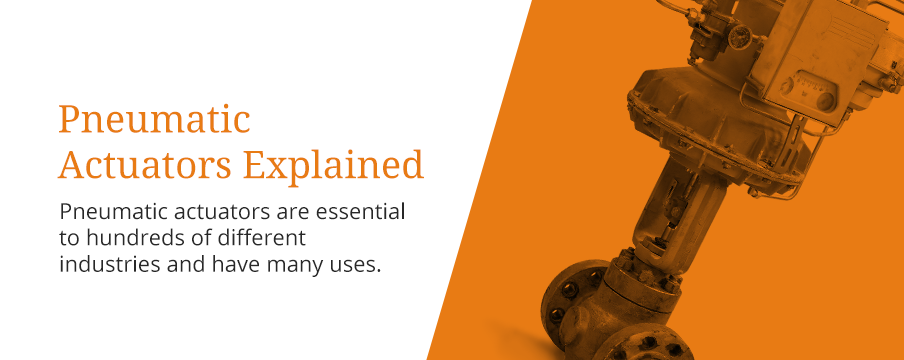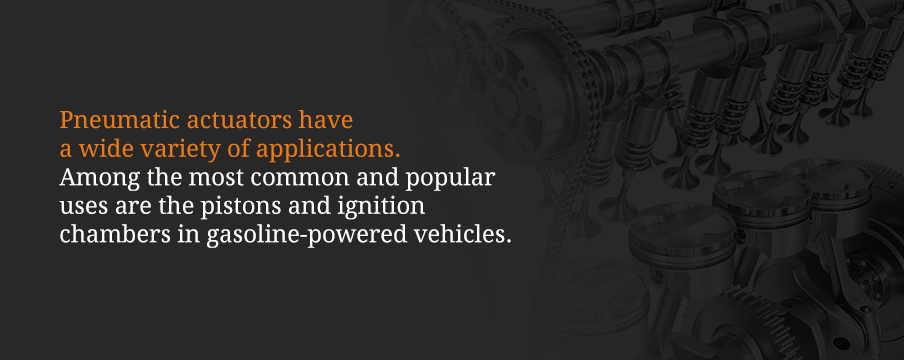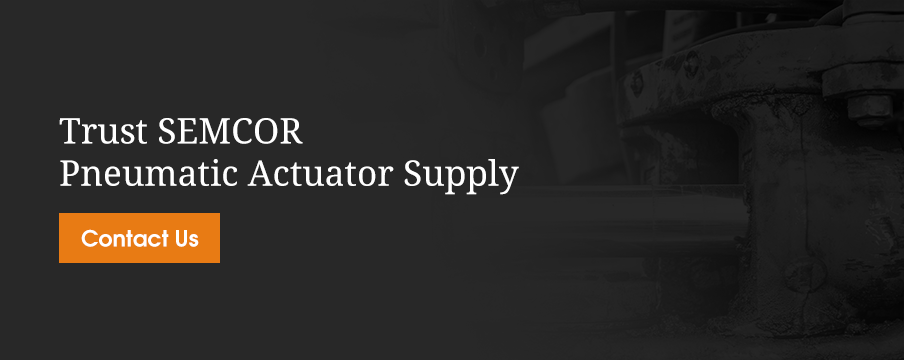Pneumatic Actuators Explained

Pneumatic actuators are essential to hundreds of different industries and have many uses. To understand how you can apply pneumatic cylinders, you should familiarize yourself with the fundamentals.
This guide will answer the questions: what is a pneumatic actuator, how does an actuator work, what are the different types available and what is the function of a pneumatic actuator?
What Is a Pneumatic Actuation System?
Pneumatic actuators are highly reliable, efficient and safe sources of motion control that use pressurized air or gas to convert energy into rotary or linear motion. They’re especially appropriate for the repeated opening and closing of valves and other industrial applications where the use of electricity may cause a fire or ignition hazard. Actuators are commonly used to control the valves that direct the movement of fluids in the chemical and process industries.
Pneumatic actuators have several different names, including pneumatic cylinders, air cylinders and air actuators. Each of these terms is synonymous with the other, as they all identify the device as air pressure based. Another name for an air cylinder is pneumatic ram, in which the ram is referring to the linear piston.
How Does a Pneumatic Actuator Work?
Pneumatic actuators rely on some form of pressurized gas — most often compressed air — entering a chamber, where the gas builds up pressure. When it has built up enough pressure in contrast to the outside atmospheric pressure, it results in the controlled kinetic movement of a device such as a piston or gear. This resulting movement can be directed in either a straight line or circular motion.
Since the conversion of compressed gas into energy can be highly controlled and is reliable and repeatable, pneumatic actuators are one of the most popular mechanical devices used in a wide array of modern industries.
Types of Pneumatic Cylinders
There are two primary varieties of pneumatic linear actuators — single-acting and double-acting. They both work to push forward a piston, but the main differences are the return method and number of ports.
Single-acting cylinders have one port that allows air to flow into the cylinder. The pressure increases and pushes the piston forward or backward, depending on whether it is a push or pull type. A large spring returns the piston to its original position, preparing it for another burst of pressure. The spring is either positioned inside the cylinder or on the outside.
Double-acting cylinders operate without a spring and instead have two ports, one on either end of the piston. The first application of pressure pushes the piston forward, a step in the process that the two models share. Then, the second burst of pressure on the other side of the cylinder pushes the piston back into place. The device applies pressure back and forth to create a smooth linear motion.
Typically, double-action cylinders are better for industrial uses that require speed and strength, as they provide more force at a faster rate. They may also offer a longer lifespan before needing replacement. However, they are a more expensive option in comparison. Single action cylinders also have other advantages besides cost. They have a more straightforward design, are more compact and require half the amount of compressed air to function.
Pneumatic Actuator Applications

Pneumatic actuators have a wide variety of applications. Among the most common and popular uses are the pistons and ignition chambers in gasoline-powered vehicles. They use ignition of the air and gasoline to create the pressurized force that eventually moves the piston and converts energy into the car’s crankshaft. However, the majority of pneumatic actuators rely only on pressurized gas with no ignition to produce the desired mechanical force.
In addition to the conventional combustible automobile engine, pneumatic actuators are essential in air compressors, packaging and production machinery, mail tubes and transportation equipment like railway and aircraft applications. They’re crucial in many other industrial situations that call for switch, pump or sensor control as well.
Pneumatic vs. Electric Actuators
While pneumatic cylinders work by way of pressurized air, electric actuators use electricity to function. Electric actuators are made up of a screw, coupler and motor, such as a stepper or servo. The screw turns and moves a nut, which makes the connecting rod or carriage shift the load. While pneumatic and electric actuators have similar uses, they aren’t directly interchangeable in every industry.
These two types of actuators vary in several other ways:
- Cost: Overall, pneumatic actuators have lower initial costs than the electric variety, but each has their purposes, and either could end up saving money in operating costs. Pneumatic cylinders are the most cost-efficient when the compressor size matches the number of cylinders it’s powering. Electric actuators provide the highest level of efficiency in moderate scales, though they have low operating costs in general.
- Force: In pneumatic actuators, speed and thrust are positively linked, meaning as one increases, the other does as well. In electric actuators, thrust and speed do not have the same link, as one decreases as the other increases. You can engineer them to perform differently, but it requires higher expenses.
- Control: Where pneumatic cylinders are better for industries that need force, electric actuators provide more accurate control and positioning. The standard models of the electric variety can move with precision from hundredths to thousandths of an inch.
Advantages of Pneumatic Actuators
The benefits of pneumatic actuators stem from both their overall safety and reliability. First of all, since pneumatic actuators can convert energy into motion without ignition or electricity, they’re highly sought after in situations where sparking and combustion cannot be tolerated. In these settings, compressed air can be stored and used in an efficient and repeatable manner that poses no fire risk.
Second, since pneumatic actuators that don’t rely on combustion can be manufactured easily and are relatively simple devices, they are also extremely durable, have minimal maintenance needs and offer a long operational life when used correctly.
Trust SEMCOR Pneumatic Actuator Supply
As one of the most reliable distributors of pneumatic actuators, SEMCOR is ready to supply you with the equipment you need from leading manufacturers. In addition, thanks to our outstanding expertise and customer care, the technical support that comes with all our actuators is unbeatable. Contact us now for product descriptions, selection guidance and more.





